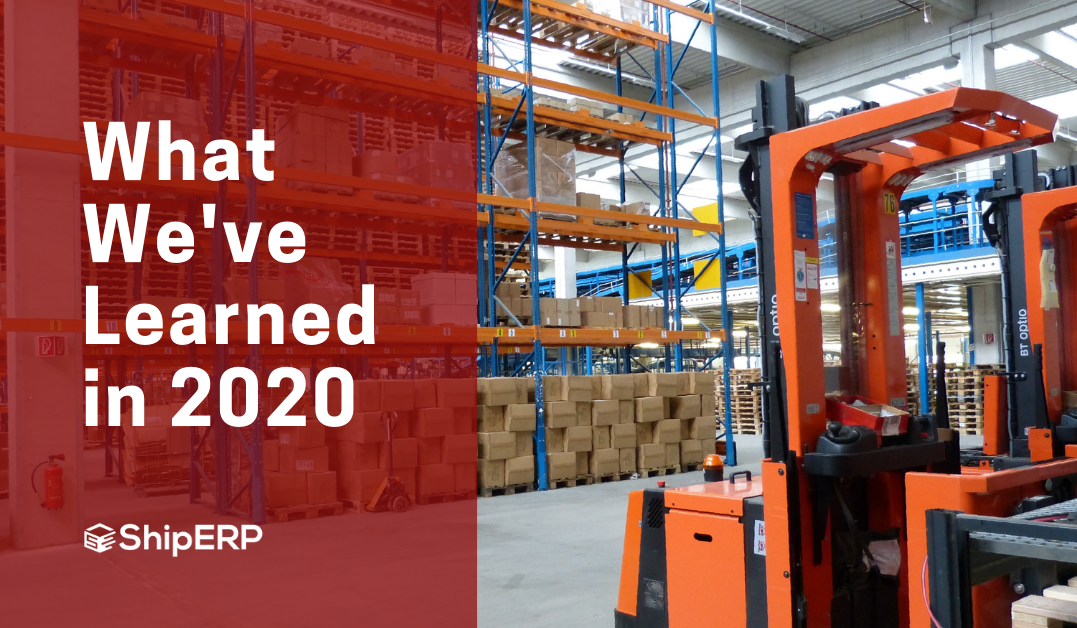
Lessons Learned: Supply Chain Disruption 2020
The COVID-19 pandemic threw the supply chain into a loop. Most, if not all your plans were thrown out or accelerated to either keep up with the demand or re-worked to fit a new business plan that satisfies customers. The volatile economy kept you on your toes and forced you to re-evaluate your supply chain processes.
As we’re approaching 2021, here are the lessons we learned to build a more resilient supply chain in the future.
12 Supply Chain Key Takeaways in 2020
- Agile companies are better off in this disruptive economy because of their previous technological investments. In contrast, companies that fell behind discovered the need to be adaptive and resilient in the face of COVID-19. If you haven’t already, it’s time to accelerate your digital transformation plans!
- An eCommerce strategy is key during COVID-19 because online shopping skyrocketed during quarantine months and even now with social distancing precautions.
- Some industries fare better than others at different points in time during the past year. Due to automation, key industries like household goods were able to keep up with unexpected levels of demand. Unfortunately, the fashion retail industry suffered in the early months of quarantine due to the higher demand for necessities.
- The influx in shipment volume revealed how you can’t rely on just one shipping carrier. There’s a need for a multi-carrier strategy in order to meet the high demand.
- Export regulations like Brexit are still in play, regardless of the state of the worldwide pandemic. Your international shipping strategy must accommodate a variety of factors.
- To resolve delivery issues as quickly as possible, you must be able to track your carriers in real-time and communicate with them at a moment’s notice.
- Many companies had to pivot their business strategy in order to adapt to the times. For example, some companies switched from B2B to B2C to keep their businesses running.
- Building resiliency requires a wider network of suppliers and partners that is flexible to quickly react to disruptions.
- Good data quality is crucial for any innovative technology to work in your favor which means your company should follow the best practices for master data governance.
- The quality and speed of important decision-making can be enhanced by cloud-based supply chain applications and collaborative platforms. With predictive analytics and machine learning, your supply chain would get the rapid insights needed be better off to combat any changes.
- For companies with international suppliers, shipping regulations that closed trader borders for months revealed a need for a domestic network.
- Quarantine regulations led to the rise of robotics in the warehouse to keep the shipping process running. With more and more affordable robotics, your supply chain will achieve efficiency, speed, and safety standards in the warehouse.
Do these key takeaways of 2020 sound familiar to you at all?
While not all the lessons learned apply to your supply chain, all companies faced the same issues of adapting to the disruption of COVID-19, regardless of how adaptable you thought your supply chain was. At the end of 2020, we’re well into the COVID-19 months and you’ve adapted as much as you can in the last year.
You’ve identified your vulnerabilities and discovered the importance of building a resilient supply chain. Technological investments in predictive analytics and automation can certainly help your business be agile and flexible in the face of disruptions. Your supply chain strategy adapted to the challenges brought by COVID-19.
The challenges presented this year in 2020 changed the course of supply chain technology trends. In many aspects, the predicted trends accelerated due to the high rise in demand and online shopping. Retail and logistics analysts say that current eCommerce sales rose to the predicted 2030 levels.
Is your supply chain prepared for 2021?
Check out our expert advice on the supply chain technology trends for next year in 2021 as a result of the disruption and challenges of 2020.
